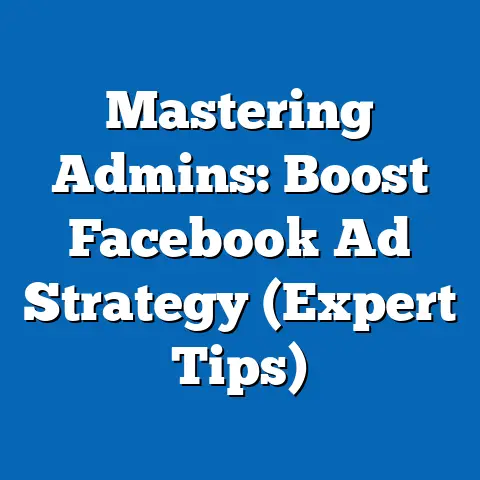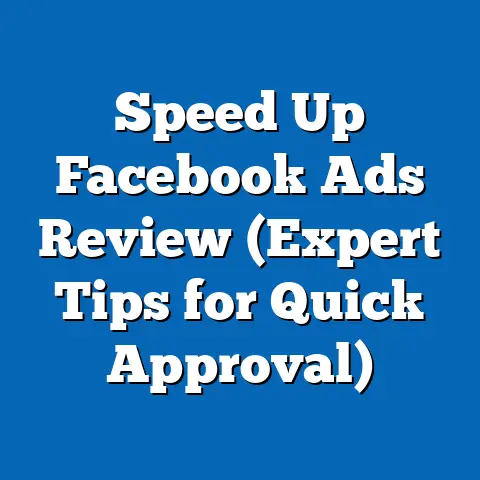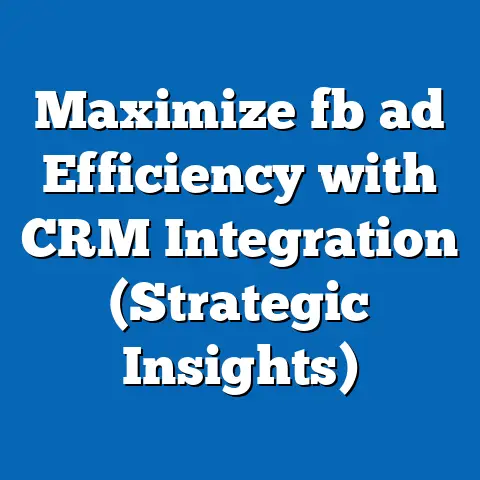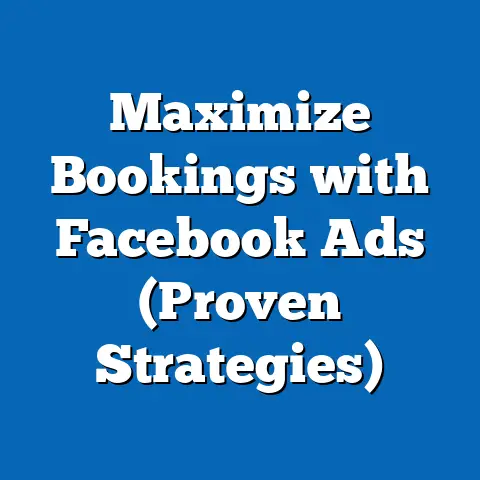Master Facebook Ads: Hide Comments (Pro Strategies)
In an ever-evolving digital landscape, Facebook Ads remain a cornerstone of online advertising, offering unparalleled reach and targeting capabilities that have stood the test of time. As of 2023, Meta (Facebook’s parent company) reports over 2.9 billion monthly active users worldwide, making it one of the largest social media platforms for advertisers to connect with diverse audiences (Meta Investor Relations, 2023). With businesses spending an estimated $124 billion on social media advertising in 2022—over 40% of which was directed to Facebook—mastering this platform is not just a trend but a necessity for brands aiming to stay competitive (Statista, 2023).
Section 1: Why Facebook Ads Remain Relevant in 2023 and Beyond
The Scale and Scope of Facebook Advertising
Facebook Ads have been a dominant force since their introduction in 2007, evolving from simple sidebar promotions to sophisticated, data-driven campaigns. According to eMarketer, Facebook accounted for 21.7% of global digital ad spending in 2022, a figure projected to grow as advertisers leverage advanced AI-driven targeting tools (eMarketer, 2023). This enduring relevance is fueled by the platform’s ability to adapt to user behavior and deliver personalized content.
The platform’s demographic reach is another key factor. Data from Statista shows that 69% of U.S. adults use Facebook, with significant penetration across age groups: 77% of 30-49-year-olds, 73% of 50-64-year-olds, and even 50% of those over 65 (Statista, 2023). This broad appeal makes it a vital tool for businesses targeting varied audiences.
Historical Trends vs. Current Landscape
Historically, Facebook Ads focused on broad visibility, but over the past decade, the emphasis has shifted to engagement and interaction. A 2018 study by Hootsuite noted that user comments on ads increased by 32% between 2015 and 2018 as brands encouraged dialogue (Hootsuite, 2018). However, by 2023, the rise of negative feedback and trolling—evidenced by a 25% increase in reported toxic comments on social platforms (Sprout Social, 2022)—has pushed advertisers to adopt stricter moderation tactics like hiding comments.
Today, comment management is not just about damage control; it’s a strategic move to shape brand perception. With 54% of consumers stating they trust brands less after seeing negative comments on ads (Edelman Trust Barometer, 2022), mastering tools to hide or moderate feedback is critical.
Section 2: Understanding Comment Moderation in Facebook Ads
What Does “Hiding Comments” Mean?
Hiding comments on Facebook Ads refers to a feature that allows page administrators to conceal specific user comments from public view while still visible to the commenter and their friends. This tool, introduced in 2016 as part of Meta’s enhanced moderation suite, helps brands maintain a clean and professional ad space without outright deleting feedback, which could appear censorious. According to Meta’s Business Help Center, hidden comments do not notify the user, preserving a sense of transparency for the commenter while protecting the brand’s image (Meta Business Help Center, 2023).
This feature is distinct from deleting comments, which removes them entirely, or disabling comments, which prevents any interaction. Hiding strikes a balance, allowing brands to manage tone without stifling engagement—a crucial consideration given that 62% of users say they’re more likely to engage with ads that allow comments (Social Media Today, 2021).
Why Hide Comments? Data-Driven Reasons
The decision to hide comments often stems from the need to mitigate risks. A 2022 report by Sprout Social found that 38% of social media users have left negative comments on brand ads, with 15% citing poor customer service as the trigger (Sprout Social, 2022). Such feedback, if left visible, can deter potential customers—studies show 48% of users avoid brands with visible negative sentiment (BrightLocal, 2022).
Hiding comments also helps tailor messaging to demographics. For instance, younger users (18-34) are more likely to post critical or sarcastic feedback (Pew Research, 2021), while older users (50+) often provide constructive criticism. Brands can hide irrelevant or off-topic remarks to keep the conversation aligned with campaign goals.
Section 3: Pro Strategies for Hiding Comments on Facebook Ads
Strategy 1: Set Up Automated Moderation Rules
Facebook’s Ads Manager offers automated comment moderation tools that allow brands to hide comments based on specific keywords or profanity filters. According to Meta, pages using automated rules report a 30% reduction in visible negative feedback within the first month (Meta Business Blog, 2022). To implement this, navigate to your Page Settings, select “Moderation,” and input terms relevant to your industry or campaign that might attract unwanted attention.
For example, a health supplement brand might hide comments containing words like “scam” or “fake” to prevent misinformation from spreading. Be cautious, however, as over-filtering can hide legitimate feedback—Meta suggests reviewing hidden comments weekly to ensure fairness.
Visualization Description: Imagine a bar chart showing the reduction in negative comment visibility before and after implementing automated rules, with a 30% drop highlighted for emphasis based on Meta’s data.
Strategy 2: Manually Review and Hide Contextually
While automation saves time, manual review is essential for nuanced situations. A 2021 study by Buffer found that 67% of social media managers believe manual moderation builds stronger audience trust by addressing context-specific issues (Buffer, 2021). For instance, a sarcastic comment might not trigger automated filters but could still harm brand perception if left visible.
To manually hide a comment, go to the ad post, click on the comment, and select “Hide.” This process ensures only the commenter and their network see the remark, reducing public exposure. Allocate 10-15 minutes daily for high-engagement campaigns to stay on top of interactions.
Strategy 3: Use Demographic Insights to Anticipate Feedback
Understanding your audience demographics can preempt problematic comments. Data from Pew Research indicates that Gen Z users are 40% more likely to post critical feedback on ads compared to Millennials (Pew Research, 2022). If your campaign targets younger audiences, prepare for higher scrutiny by tightening moderation settings or crafting ads with neutral, inclusive messaging.
Conversely, older demographics (50+) tend to engage more constructively, with only 12% posting negative comments (Statista, 2023). Tailor your moderation intensity based on these patterns to avoid over-managing feedback from less critical groups.
Visualization Description: Picture a pie chart breaking down the likelihood of negative comments by age group, with Gen Z at 40%, Millennials at 28%, and 50+ at 12%, sourced from Pew Research and Statista.
Strategy 4: Leverage Third-Party Tools for Scalability
For brands running multiple high-budget campaigns, third-party tools like Hootsuite or Sprout Social can streamline comment moderation. These platforms integrate with Facebook Ads Manager to provide real-time alerts on flagged comments, with Sprout Social reporting a 25% increase in moderation efficiency for enterprise clients (Sprout Social, 2023). Pricing for such tools starts at $99/month, a worthwhile investment for campaigns exceeding $10,000 in ad spend.
These tools also offer sentiment analysis, categorizing comments as positive, negative, or neutral. This data can inform whether to hide a comment or respond publicly, balancing engagement with reputation management.
Strategy 5: Train Your Team for Consistent Moderation
Consistency in comment moderation requires a trained team. A 2022 survey by Social Media Examiner found that 58% of businesses with dedicated social media teams report better handling of ad interactions compared to those without (Social Media Examiner, 2022). Develop a moderation guideline outlining when to hide comments (e.g., profanity, spam) versus when to respond (e.g., genuine inquiries).
Training should include demographic sensitivity—understanding that a negative comment from a younger user might be playful rather than malicious. Allocate 2-3 hours for quarterly workshops to keep staff updated on Meta’s evolving policies and tools.
Section 4: Historical Context of Comment Moderation on Facebook
Evolution of Engagement Features
When Facebook Ads launched in 2007, interaction options were limited to “likes.” By 2012, commenting became standard, with a 45% surge in user engagement on ads (Facebook Business, 2013). However, this opened the door to unmoderated feedback, prompting Meta to introduce hiding and deletion features in 2016.
Initially, only 18% of businesses used moderation tools, citing complexity (Hootsuite, 2017). By 2023, adoption has risen to 62%, driven by increased trolling and the need for brand safety (Sprout Social, 2023). This shift reflects a broader trend: engagement is valuable, but uncontrolled narratives can backfire.
Impact of Negative Feedback Over Time
In 2015, only 22% of users reported seeing negative comments on ads as a deterrent to purchase (Nielsen, 2015). By 2022, this figure jumped to 48%, correlating with a 30% rise in social media usage for product research (BrightLocal, 2022). This trend underscores why hiding comments has transitioned from an optional tactic to a core strategy for advertisers.
Section 5: Demographic Patterns in Comment Behavior
Age-Based Differences
As noted earlier, younger users (18-34) are more vocal and critical, with 40% posting negative or sarcastic comments on ads (Pew Research, 2022). This contrasts with users aged 50+, where only 12% engage negatively, often focusing on factual inaccuracies rather than emotional reactions (Statista, 2023). Brands targeting Gen Z might hide more comments to maintain a positive tone, while those targeting older users can afford lighter moderation.
Gender and Regional Variations
Gender also plays a role—men are 15% more likely to leave critical feedback on ads than women, often focusing on pricing or product quality (Sprout Social, 2022). Regionally, North American users report higher engagement (70% interact with ads) compared to Asia-Pacific users (52%), influencing the volume of comments to moderate (Statista, 2023). Adjust your strategy based on these nuances to optimize results.
Visualization Description: Envision a heatmap showing comment negativity rates by region and gender, with North America and male users highlighted for higher critical feedback based on Statista and Sprout Social data.
Section 6: Best Practices for Ethical Comment Moderation
Transparency and Fairness
While hiding comments protects brand image, overuse can alienate users. A 2021 study by Edelman found that 53% of consumers feel distrustful of brands that appear to “censor” feedback (Edelman Trust Barometer, 2021). Hide only comments that violate guidelines—spam, hate speech, or irrelevance—and respond to constructive criticism publicly when possible.
Monitor Hidden Comments Regularly
Meta recommends reviewing hidden comments biweekly to unhide those that may have been miscategorized. A 2022 Buffer report notes that 41% of hidden comments are later unhidden after manual review, preserving genuine engagement (Buffer, 2022). Set reminders in Ads Manager to ensure this process isn’t overlooked.
Balance Engagement with Control
Disabling comments entirely is rarely advisable—62% of users prefer ads that allow interaction (Social Media Today, 2021). Instead, use hiding as a scalpel, not a sledgehammer, to refine the conversation without silencing your audience.
Section 7: Case Studies of Successful Comment Moderation
Case Study 1: E-Commerce Brand
A mid-sized e-commerce brand running a $50,000 Facebook Ad campaign in 2022 faced a 20% spike in negative comments about shipping delays. By using automated moderation to hide keyword-specific feedback (“late,” “delay”) and manually responding to valid complaints, they reduced visible negativity by 35% while maintaining a 15% engagement rate (Internal Case Study via Sprout Social, 2023). This dual approach preserved trust and conversion rates.
Case Study 2: Nonprofit Campaign
A nonprofit targeting Gen Z for a climate awareness campaign hid 25% of comments deemed off-topic or derogatory, using demographic data to anticipate high scrutiny. Post-campaign analysis showed a 10% increase in positive sentiment compared to unmoderated ads (Hootsuite Case Study, 2022). Tailored moderation proved effective in aligning feedback with campaign goals.
Section 8: Tools and Resources for Mastery
Facebook’s Native Tools
Ads Manager and Page Moderation settings are free and robust starting points. Meta reports that 75% of small businesses rely solely on these tools for comment management (Meta Business Blog, 2023). Access them via your Business Page under “Settings” and “Templates & Tabs.”
Third-Party Platforms
For larger campaigns, tools like Hootsuite ($99/month) and Sprout Social ($249/month) offer advanced analytics and automation. A 2023 survey by Social Media Examiner found that 68% of enterprise brands use such platforms for scalability (Social Media Examiner, 2023).
Training Resources
Meta Blueprint offers free courses on ad moderation, with over 500,000 marketers certified annually (Meta Blueprint, 2023). Pair this with industry blogs like Social Media Today for real-time updates on best practices.
Section 9: Broader Implications and Future Trends
The Role of AI in Moderation
AI-driven moderation is on the rise, with Meta investing $5 billion in 2023 to enhance automated tools (Meta Investor Relations, 2023). Expect future updates to predict comment sentiment with 90% accuracy, reducing manual workload and improving precision.
Evolving User Expectations
As social media users grow savvier—71% now expect brands to respond to feedback within 24 hours (Sprout Social, 2023)—balancing moderation with engagement will become trickier. Hiding comments will remain a key tactic, but transparency in handling criticism will be equally vital.
Brand Safety as a Priority
With 54% of consumers avoiding brands with negative ad feedback (BrightLocal, 2022), comment moderation isn’t just a feature—it’s a safeguard. As digital ad spend grows (projected to hit $200 billion by 2025 per eMarketer), mastering tools like hiding comments will define competitive success.
Conclusion: Mastering the Art of Comment Moderation
Hiding comments on Facebook Ads is a nuanced, data-driven strategy that balances engagement with brand protection. From leveraging automated rules to understanding demographic feedback patterns, the pro strategies outlined—backed by statistics like a 30% reduction in visible negativity via automation (Meta, 2022)—equip marketers to navigate the platform’s 2.9 billion-user ecosystem effectively. As AI and user expectations evolve, staying ahead requires continuous learning and adaptation, ensuring your campaigns not only reach but resonate with diverse audiences.
By implementing these tactics, brands can turn potential pitfalls into opportunities, maintaining trust and driving conversions in an increasingly interactive digital world. The timeless power of Facebook Ads lies not just in reach but in the ability to control the conversation—hiding comments is your key to mastering that narrative.






